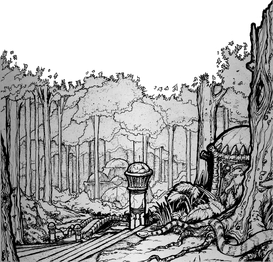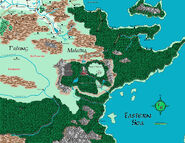The Malatran Plateau was a mountainous land form in the center of the southern jungles of Malatra that was created by alien magic and rose thousands of feet above the rest of the region.[3]
Geography[]
Like the rest of Malatra, the Malatran Plateau was covered mostly by jungle. In the north west and the north east however, there were large swathes of land that didn't have significant tree cover.
History[]
Some of the earliest people to inhabit the land that would become the Malatran Plateau were bamboo and river spirit folk,[3] who would later become an offshoot race known as the tam'hi.[4]
Thousands of years before the Time of Troubles and before Abeir-Toril had split,[note 1][note 2] a faction of a humanoid race known as the ancient Nubari had come on spelljammers in retreat from war in another crystal sphere, seeking a new place to call home. Viewing the central jungle of Maltra as undesirable to the natives, they used their magic to raise the ground and create the vast Malatran Plateau.[3][5] Unbeknownst to them, this caused the underground homes of nearby korobokuru to collapse, forcing them above ground.[4]

Overgrown ruins and magical domes of the ancient Nubari civilization.
Vowing not to repeat the mistakes of their ancestors, they swore to create a society without war[3][5] and to not interfere with the natural development of other species.[4] The land's spirit folk chose to hide instead of greeting or troubling them[3][5] and the timid shu chose to do the same.[4] Thus these groups lived in harmony as the ancient Nubari worked to create a new utopia free of strife. The ancient Nubari built a long chain of magical domes around their territory, which generated a effect similar to the hallucinatory terrain spell, but with permanency and on a massive scale. They also wove powerful and permanent variations of the antipathy spell into the domes. Altogether this ensured that the plateau, as well as the domes that made this effect, would go unnoticed by the people below.[3][5]
When garuda began decimiating the plateau's gorilla population, the ancient Nubari felt sorry for the creatures and decided to make them smarter. Giving them the capability of speech and the knowledge of making tools. When the garuda were eventually banished from the land, the ancients would go on to offer many saru jobs as laborers.[4]
Eventually some disaster, whose exact details were unrecorded by history, struck the ancient Nubari and destroyed their civilization. Most of their buildings, culture, and knowledge was lost in this disaster.[3][5] A legend passed down by members of the Simbara claimed that they were discovered and attacked by their ancient enemy.[6] The surviving ancient Nubari would flee what was left of their homes, taking up life in the plateau's jungles and plains.[5]
Years following the destruction of the ancient Nubari's civilization, some native Malatrans discovered the plateau. During this period the carnivorous dinosaurs that inhabited the jungles surrounding the plateau were experiencing a severe decline in population. These natives — consisting of humans, katangas, and korobokurus — somehow managed to ascend the vast plateau and overcome its magical barriers.[3][5] These humans were related to those who would later become the Shou.[3][7]
Those humans would intermingle with the ancient Nubari and over the course of thousands of years they descended into the modern Nubari.[3][5][7] Later on,[4] a group of scro came on spelljamming vessels to the Malatran Plateau, fleeing from their far off war with the Elven Imperial Fleet. And over time they descended into what would be known as the oscray.[3][8][note 3]
Inhabitants[]
The intelligent races that populated the Malatra Plateau included the Nubari, katanga, korobokuru, saru, shu, tam'hi,[5][7] and oscray.[8] With the Nubari, korobokuru, and shu living in tribes. The saru sometimes settled near Nubari villages and mimicked their habits, but never created tribes of their own.[7] The tam'hi lived in clans of families rather than tribes.[9]
The Nubari tribes were broad groups of villages tied by blood relation, with villages of the same tribe only rarely going to war with one another.[7] Relations with the Nubari tribes and other races were generally good,[10] with most Nubari considering all humans and demihumans to be people, though in some cases tribes only considered humans to be people.[7] Almost all tribes considered korobokuru and shu to be people, with outcasts joining their tribes on rare occasions. Larger tribes were known to adopt even outcast katanga, tam'hi, and saru.[10]
The more monstrous races that inhabited the plateau, known for often raiding the aforementioned peoples, included bullywugs, lizardfolk, mold men, a fresh water breed of sahuagin, tabaxi, tasloi, wemics, and yuan-ti.[11]
Notable Features[]
- Fire Mountain: The southernmost peak of the plateaus central mountain range was an active volcano. Many legends had grown up around the mount and several tribes based their primitive religions on it.[3]
- Rayana Savanna: One of the two great plains of the plateau. An area of rolling grasslands and plentiful watering holes where elephants, gazelles, lions, and zebras could be found. Nubari plainsmen had tilled a few fields where the jungle met the grass and the aarakocra maintained all of their low-land villages in the middle of the savanna.[3]
- Valley of Spirits: Where the River of Laughing Idols fell from a high cliff was the beginning of this valley which widened out until it reached the Himsala Mountains at the south east edge of the Plateau. Constantly shrouded in mist from the waterfall, the Valley was mysterious and the greatest of Nubari taboo places. Alien screams filled the air and those few who returned from the valley always refused to speak of what they saw and never again ventured back.[3]
- Yaku Plains: Also known as the Plains of Ash, was the second great plain of the plateau. It was once a hilly savannah populated with Nubari, until one day a great fire blasted it into a wasteland covered in grey ash and husks of trees. When and how this fire occurred is unknown to the Nubari. Vegetation failed to grow here despite being surrounded on all sides by thick jungle and many cultures viewed this land as taboo. Aspiring witch doctors and shamans among the Nubari were often brought here by their instructors to be told a vague lesson about the foolishness of man.[3]
Appendix[]
| This article is incomplete. You can help the Forgotten Realms Wiki by providing more information. |
Notes[]
- ↑ The events of the Living City Ravens Bluff and the Living Jungle campaigns took place on a timeline that advanced together with the real world's time. Even though all Living City/Living Jungle adventures were dated with real-world dates and year names on the Malatran calendar, there were events that received a DR year. The Living City timeline can be derived from Myrkyssa Jelan's historic events of the late 14th century DR. Myrkyssa Jelan attacked Ravens Bluff in 1370 DR, according to The City of Ravens Bluff and Forgotten Realms Campaign Setting 3rd edition; these events are chronicled in an in-and-out of universe issues of Ravens Bluff Trumpeter. This places the real world year 1997 as 1370 DR, and in 1998 (1371 DR). As the real world's months and the Calendar of Harptos are virtually identical, we can also date all events of the Living City Ravens Bluff as close as an in-universe month. Using that data, we can use the Legacy of the Headshrinker to date the Living Jungle adventures. The adventure features Malatran heroes traveling to the Vast and meeting several player character from the Living City campaign. Legacy of the Headshrinker takes place in 2000 – The Year of Great Change, which correlates with 1373 DR. This means other named years in the Living Jungle campaign can receive a DR conversion: The Year of Awakening (1995) – 1368 DR;The Year of Discovery (1996) – 1369 DR;The Year of New Peoples (1997) – 1370 DR;The Year of Gathering Darkness (1998) – 1371 DR; The Year of Sorrow and Hope (1999) – 1372 DR;The Year of Great Change (2000) – 1373 DR;The Year of Tigers Curse (2001) – 1374 DR;The Year of Despair (2002) – 1375 DR;The Year of Lion's Victory (2003) – 1376 DR.
- ↑ No date for the Living Jungle setting is given in any of the official material. This article assumes that it takes place around the time of the second and third editions, based on the time period when the material was released.
- ↑ Though scro were not specifically named in their entry, the description and background of oscray heavily mirrors them. In addition, they reuse the art used for scro in Monstrous Compendium Spelljammer Appendix II.
Gallery[]
References[]
- ↑ Tom Prusa, Stephen H. Jay (September 2001). Come the Lion (PDF). Living Jungle (RPGA), p. 11.
- ↑ Kevin Melka (June 1995). “Jungle Lore”. In Duane Maxwell ed. Polyhedron #108 (TSR, Inc.), p. 16.
- ↑ 3.00 3.01 3.02 3.03 3.04 3.05 3.06 3.07 3.08 3.09 3.10 3.11 3.12 3.13 3.14 3.15 Stephen H. Jay, Robert Farnsworth (January 2000). Living Jungle Campaign: Player Information Guide (PDF). Living Jungle (RPGA).
- ↑ 4.0 4.1 4.2 4.3 4.4 4.5 Jungle Tales #11 (HTML). RPGA Living Jungle. Wizards of the Coast. (June 2000). Archived from the original on 2001-06-17. Retrieved on 5/10/2021.
- ↑ 5.0 5.1 5.2 5.3 5.4 5.5 5.6 5.7 5.8 Uncredited (December 1994). “The Living Jungle”. In Jean Rabe ed. Polyhedron #102 (TSR, Inc.), p. 5–7.
- ↑ Stephen H. Jay (April 1998). “Jungle Tales”. In Jeff Quick ed. Polyhedron #129 (TSR, Inc.), p. 17.
- ↑ 7.0 7.1 7.2 7.3 7.4 7.5 Uncredited (December 1994). “Tribes of the Nubari”. In Jean Rabe ed. Polyhedron #102 (TSR, Inc.), p. 8.
- ↑ 8.0 8.1 Stephen H. Jay, David Morrow, Tom Prusa and Gary Watkins (April 1998). “More Living Jungle Races”. In Jeff Quick ed. Polyhedron #129 (TSR, Inc.), p. 35.
- ↑ Uncredited (December 1994). “Malatra Monstrous Compendium Sheets”. In Jean Rabe ed. Polyhedron #102 (TSR, Inc.), p. 23.
- ↑ 10.0 10.1 Uncredited (December 1994). “Tribes of the Nubari”. In Jean Rabe ed. Polyhedron #102 (TSR, Inc.), p. 11.
- ↑ Uncredited (December 1994). “Tribes of the Nubari”. In Jean Rabe ed. Polyhedron #102 (TSR, Inc.), p. 12.


